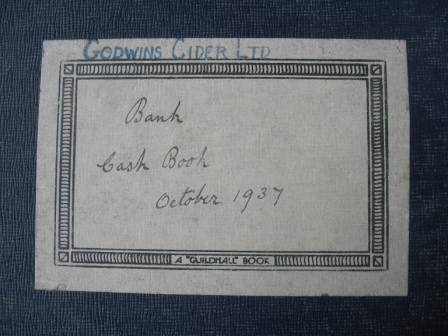
THE ARCHIVE OF CIDER POMOLOGY
National Association of Cider Makers The Cider Museum Long Ashton Research Station East Malling Research Station Brogdale
In 2009 The Hereford Cider Museum Trust, supported by the Pippin Trust and the National Association of Cider Makers established a dedicated repository for pomology and cider archives. A new purpose made archive store was built within the long established Cider Museum at Hereford, and in November 2009 a part time archivist appointed.
The archive is funded by The National Association of Cider Makers and exists to preserve and safeguard the records and archives of the cider and perry industry. The information held is of particular interest to cider makers, apple growers, agricultural organisations, government, scholars and the heritage industry.
The archive is currently cataloguing collections from the main depositors. It welcomes relevant new material.
ACP Catalogue and Documents on Line
The ACP archive catalogue is available in searchable form on this website with as many documents as possible downloadable. Click here to search the catalogue. Click here to view downloadable documents.
Our main collections derive from:
The National Association of Cider Makers (NACM) promotes the cider and perry industry in the UK. It represents the nine main producers (Bulmers, Thatchers, Gaymers, Westons, Sheppys, Merrydown, Aspall, Aston Manor, Magners) which account for nearly 90% of sales, and the many hundreds of smaller scale cider makers through their regional associations (four of them) which are affiliated to the NACM. It was founded in 1927. In the 1990s it took over the research work of the Long Ashton Research Centre (see below). In 1993 it established trial orchard at Rosemaund Agricultural Research Centre, Preston Wynne, Herefordshire. This was sold in 2008 and research is commissioned in different locations.
It produces newsletters, reports and support for its members and runs an informative website. www.cideruk.com
The Archive of Cider Pomology contains publications from the NACM from the 1960s to the present day

The Cider Museum has a large archive of Pomonas, photographs, trade books, newspaper cuttings and artefacts which has been collected since the museum was established in 1973. This archive has a good catalogue based on a card index but much of the information, e.g. growing books and accounts, has only been broadly catalogued. Future work will aim to catalogue the collection in more detail and present it in digital form.
The archive is currently cataloguing the Pulling Papers. William Pulling and Sons were spirit, wine and cider merchants and distillers of gin in Hereford between 1812 and 1978. About ten boxes of receipts, orders, letters, account books and other papers were donated to the archive. These papers contain a wealth of detail about life in Hereford for a prosperous family and about the drinks trade in Wales and the Marches. Though only about one tenth has been catalogued so far the list is available here in .pdf form and maybe useful for people researching 19th century life in Hereford and Wales.
Long Ashton Research Station began in 1893 by an individual cider producer on his own orchard near Glastonbury. This led to the formation of the National Fruit and Cider Institute in 1903 who took over fields south of the main road through Long Ashton.
In 1912 the Institute became part of the University of Bristol's Department of Agricultural and Horticultural Research and its name was changed to Long Ashton Research Station. The centre grew with new labs and lands. In 1931 the Agricultural Research
 |
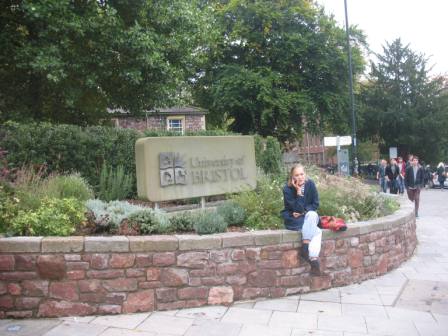 |
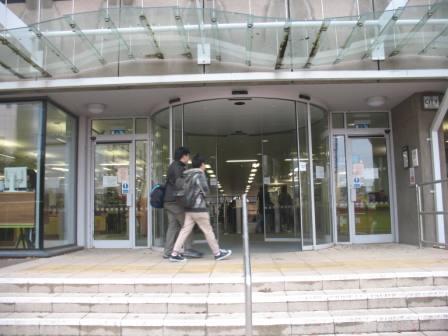 |
||
|
Long Ashton Research Station began in 1893 |
In 1912 it became part of the University of Bristol |
In 2003 it was closed. The archive is held in the Library of the University of Bristol |
Council (ARC), a Government body took over the management of LARS. A new Unit of Plant Nutrition was set up and the centre continued to expand into crops but in 1981 two of Long Ashton's major research divisions, the Pomology and Plant Breeding Division and the Food and Beverage Division were closed down and arable crops replaced pomology as the main focus of research.
In 2003 Long Ashton was closed altogether. Some staff were
moved to Rothamsted, providing some continuity with research programmes but the
site itself was sold and redeveloped for housing.
In 1990 the National Association of Cider Makers took over the responsibility for cider pomology research following the closure by MAFF of the Long Ashton Research Station. Three major producers, Bulmers, Taunton and Showerings contributed £50k to the cost of research work and members of two growers associations Herefordshire and Norton in Somerset paid a 25p/tonne levy to the research fund. The NACM appointed its own Field Officer, Liz Copas to lead the research projects covering all aspects of cider fruit growing.
The Archive of Cider Pomology contains pomology reports and annual publications from LARS and a number of other technical reports in digital form. The LARS archive is currently lodged at Bristol University Archive. The archive can be accessed at the Science Library Bristol University and the online archive can be viewed on their on line catalogue at http://oac.lib.bris.ac.uk/dserve/
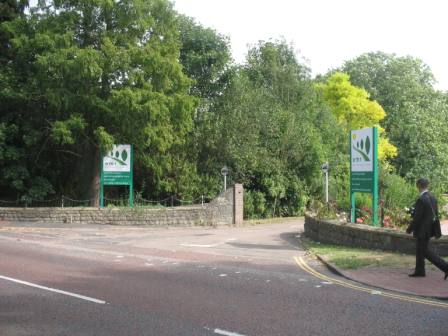 The
East Malling and Wye Fruit Experimental Station was established in 1913 under
the impetus of local fruit growers. The first Director, R. Wellington, defined
the task of the Station as the study of problems which are met within the
culture of fruit trees and bushes. Today the EMR is an independent
research and educational centre, mainly for fruit but also for vegetables and
flowers. It is located in Kent, just we
The
East Malling and Wye Fruit Experimental Station was established in 1913 under
the impetus of local fruit growers. The first Director, R. Wellington, defined
the task of the Station as the study of problems which are met within the
culture of fruit trees and bushes. Today the EMR is an independent
research and educational centre, mainly for fruit but also for vegetables and
flowers. It is located in Kent, just we st
of Maidstone, about ten minutes walk from East Malling railway station.
The original building is still in use as part of the East Malling Enterprise
Centre, but it is surrounded by many other laboratories, offices, greenhouses
and storage rooms and set in extensive grounds of orchards and fields.
st
of Maidstone, about ten minutes walk from East Malling railway station.
The original building is still in use as part of the East Malling Enterprise
Centre, but it is surrounded by many other laboratories, offices, greenhouses
and storage rooms and set in extensive grounds of orchards and fields.
Eas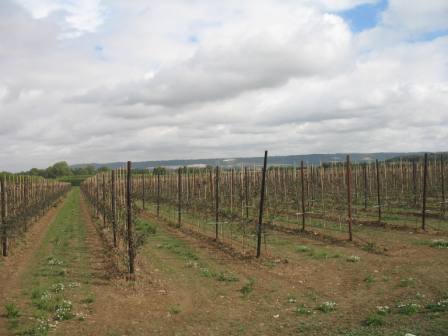 t Malling became an independent Research Institute in 1920 under the name
Kent Incorporated Society for Promoting Experiments in Horticulture, afterwards
becoming known as the East Malling Research Station (EMRS) for the next 65
years. In the 1970ís with the close integration of horticultural research in
England, EMRS became the AFRC Institute of Horticultural Research, East Malling.
t Malling became an independent Research Institute in 1920 under the name
Kent Incorporated Society for Promoting Experiments in Horticulture, afterwards
becoming known as the East Malling Research Station (EMRS) for the next 65
years. In the 1970ís with the close integration of horticultural research in
England, EMRS became the AFRC Institute of Horticultural Research, East Malling.
The Institute
of Horticultural Research
governing body was responsible for research stations around the UK at East
Malling which specialised in fruit, hardy ornamentals, farm woodlands), Littlehampton, Wellesbourne
which specialised in field vegetables and the Hop Research Department at Wye College. In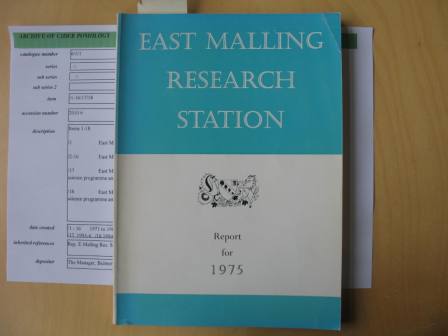 1990,
Horticulture Research International was established from a merger between the
IHR and the Agricultural Development Advisory
Service (ADAS) Experimental Horticulture stations at Efford, Kirton and
Stockbridge House. HRI was sponsored by Defra as a Non-Departmental Public Body. The arrangement was dissolved on 1st April 2004 when East Malling
Research became an independent company again.
1990,
Horticulture Research International was established from a merger between the
IHR and the Agricultural Development Advisory
Service (ADAS) Experimental Horticulture stations at Efford, Kirton and
Stockbridge House. HRI was sponsored by Defra as a Non-Departmental Public Body. The arrangement was dissolved on 1st April 2004 when East Malling
Research became an independent company again.
Over the years, some of the finest and most important research on perennial crops in the world has been conducted at East Malling. Widely adopted developments have been achieved in the areas of fruit plant culture (especially the development of the Malling rootstocks for apples used almost exclusively in the UK), agronomy, fruit breeding, post-harvest storage and the biology and control of pests and diseases.
The Archive of Cider Pomology contains reports and analysis of orcharding in the East Malling Annual Reports that were collected and used by the Bulmer's Fruit Office between the 1960s and 2000s
 Brogdale, near Faversham in Kent is home to the The National Fruit Collection.
It began in 1952 when the Ministry of Agriculture bought a farm of 183 acres
plus a large number of buildings and a farm house at Brogdale in order to
establish fruit trials for the burgeoning market garden trade. They had
been searching for sometime for a suitable frost free place to transfer the
apple collection from Wisley, its previous apple research centre that had no
room for expansion and was anyway prone to frosts. Over the years at
Brogdale the fruit trials, number of staff and apple varieties soared, until
1990 when Government cut its funding, handing over fruit trialling to the
market, rather than the state. The centre continued however with a mixture
of government, private and general public support.
Brogdale, near Faversham in Kent is home to the The National Fruit Collection.
It began in 1952 when the Ministry of Agriculture bought a farm of 183 acres
plus a large number of buildings and a farm house at Brogdale in order to
establish fruit trials for the burgeoning market garden trade. They had
been searching for sometime for a suitable frost free place to transfer the
apple collection from Wisley, its previous apple research centre that had no
room for expansion and was anyway prone to frosts. Over the years at
Brogdale the fruit trials, number of staff and apple varieties soared, until
1990 when Government cut its funding, handing over fruit trialling to the
market, rather than the state. The centre continued however with a mixture
of government, private and general public support.
Today Brogdale is one of the largest fruit collections in the world. It is owned by
the Government Dept for Environment, Food and Rural Affairs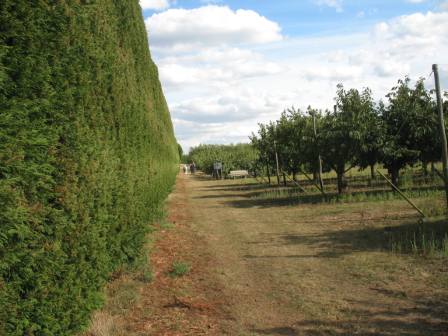 (Defra), though the university of Reading has
now taken over management with the Farm Advisory Service Team (FAST) and the public access
is organised by Brogdale Collections Trust, who are developing the site as a visitor
attraction.
(Defra), though the university of Reading has
now taken over management with the Farm Advisory Service Team (FAST) and the public access
is organised by Brogdale Collections Trust, who are developing the site as a visitor
attraction.
The National Fruit Collection includes over 2,300 named
Apple varieties, 550 Pear, 350 Plum, 220 Cherry with a number of Bush fruit, Vine and Cob Nut cultivars.
The collection is part of an international programme to protect plant
genetic resources for the future. It has a searchable database of apple
types on its website at:
http://www.nationalfruitcollection.org.uk/index.php 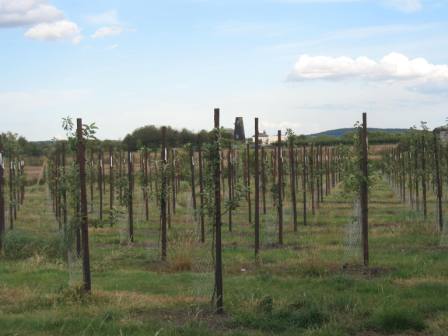
Two of each cultivar are grown with a programme of renewal which takes several years and several acres to accomplish. Current renewals are on the three spear rootstock scheme.
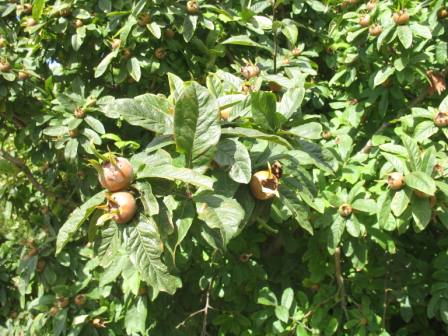 Brogdale
did little cider fruit research, and The Archive of Cider Pomology as yet contains very little
material from Brogdale
Brogdale
did little cider fruit research, and The Archive of Cider Pomology as yet contains very little
material from Brogdale